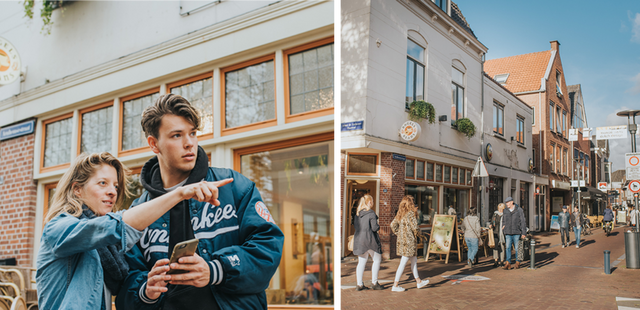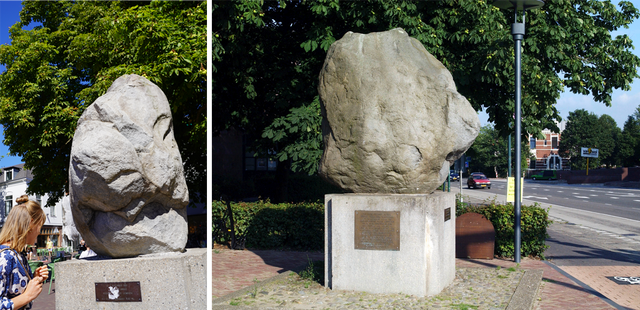Although we Amersfoorters usually shine with pride when it comes to our rich history. Sometimes we also feel a little embarrassed. Like the story about 'the Kei'. This is the story of the Kei Quarter, but not our brightest moment. That's why I hide this embarrassing affair behind all sorts of other interesting facts. But, I promise to share this embarrassing moment of Amersfoort with you as well. Pinky promise!
The Boulder Quarter

For those who don't quite have the subdivisions of Amersfoort in focus. The Keikwartier covers the following streets: Arnhemsestraat, Koestraat, Koesteeg, Grote- and Kleine Haag, Achter de Arnhemse Poortwal, the Varkensmarkt and Slijkpoortsteeg. Besides a piece of history, you will find cozy boutiques and various restaurants in this subarea.
The vanished city gate
Let me start at the Slijkpoortsteeg. This name is related to De Slijkpoort from 1420. It got the name slijk because the ground outside the gate was quite swampy. It was a rectangular gate with slate roof and simple front gate. It was once part of the second enclosure, and found at the end of Arnhemsestraat. It was also called the Leusderpoort. Because through this gate you could walk to church of Leusden.
The Slijkstraat gets a new name
Around 1822, part of the city wall collapsed. Therefore, eight years later, the Slijkpoort and remnants of the wall were demolished to build a parkway. The remaining materials were used for the cavalry stables at Beestenmarkt and paving of the road to Leusden. Later, in 1957, the moat also disappeared and a ring road was built around the city. Because the present Arnhemsestraat was part of the Slijkpoort, it used to be called the Slijkstraat. The residents did not like the sound of that, so the name was changed to Arnhemsestraat in 1888.
Fun fact: Behind the Arnhem Gate Wall, traces of agricultural use from the 13th -century were found in 2014. Including a well and more than 3,000 archaeological finds.
The Pig Market

This has always been a lively square with several markets. And as the name gives away, piglets used to be traded here. But first there was a fish market. In 1552, a peat and pig market were added. The square was called St. Joostenplein until 1552, and only received its current name when the pig market moved there. In 1554 it expanded further to include a sheep market. The fish market was then moved to the Ketelaars Bridge. And the piglets, they eventually went to the Lieve Vrouwekerkhof.
The Montmartre of Amersfoort

Since 1984 you can admire artist Marius van Beek's sculpture, the Baadster and Torser, on the Pig Market. There have been plans to renew the Varkensmarkt for some time. It should become an atmospheric and green square that invites to grab a terrace or have a chat on one of the benches that will be there. That promises a lot of conviviality! The name 'The Amersfoort Montmartre' has already been mentioned.
The Cow Street
On this street you used to find a small gate called the Koepoort. This was used to bring the cattle from the city farms to the pasture outside the city. That is why it is called Koestraat and Koesteeg here. You'll also find the Mayor's House here. So named because of the foundation stone laid on June 15, 1860 by Mayor A.G. Wijers. It then functioned as a teacher's house, belonging to the Stadsarmenschool. At one time this was the site of restaurant Het Burgermeestershuys and nowadays you can eat here at restaurant Peter & Selie.
The infamous boulder
 Okay, okay ... I can't get out of it, so here goes. Before you read it, remember that gullibility is a quality and also has something beautiful and innocent.
Okay, okay ... I can't get out of it, so here goes. Before you read it, remember that gullibility is a quality and also has something beautiful and innocent.
In the summer of 1661, Jonkheer Everhard Meyster, on the Leusderheide, found a huge boulder. He bet his friends that he would succeed in getting the Amersfoorters to drag this boulder into the city.
Beer and pretzels
With the promise of beer and fresh pretzels, 400 helpful and somewhat naive Amersfoorters set to work. With sledge and pull, the giant colossus was finally dragged into the city. That was not easy. One man even lost his legs because he ended up under the boulder. The self-styled Meyster had a commemorative medal minted for this event, as well as writing the poem Keyklucht. And if that was not enough, he incorporated various memories of his region into the house he had built in Utrecht. He called the house 'De Krakeling'.
A symbol of pride
Because it turned out to be a big joke, the poor Amersfoorters were laughed at and mocked for it. To this day, therefore, if you were born here, you are called a boulder puller. Filled with shame, the boulder pullers buried the monstrosity on the Varkensmarkt in 1672. Only to exhume it again in 1903. Enough time had passed and the people of Amersfoort could now laugh about it. The Amersfoort Kei was displayed on a pedestal on the Utrechtsestraat, as a symbol of pride. #remember
Boulders in the city

In 1932 the boulder was moved to Arnhemsestraat. And during the German occupation it was temporarily buried at Hof, for fear of damage. When the annual Keistad festivals began in the 1970s, a number of times it was decided to move boulders from various European countries through the city. That's why you come across all those big stones in the park on the City Ring.
Beer!
Although we Amersfoorters were made quite a fool of in 1661, we can also be proud. Our Amersfoort boulder weighs 7157 kilograms, has a height of 2 meters and a circumference of 5.25. And our ancestors dragged it all the way from Leusderheide to the city. And that makes us super strong, resourceful, real go-getters and people who are willing to give a lot for a beer!
Did you have a nice chuckle at our boulder on Arnhemseweg? When you have finished laughing, walk into the Keikwartier to shop at these fine stores. And then settle down at one of these nice restaurants for a tasty lunch, pie or dinner.
Source: Eemland Archives
